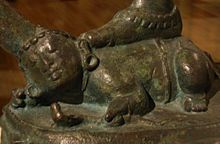Apasmara

Apasmara (Sanskrit: अपस्मार, IAST: Apasmāra) is a diminutive man who represents spiritual ignorance and ahamkara in Hindu mythology.[1][2] He is also known as Muyalaka or Muyalakan.
Etymology and definition
[edit]The suffix smāra (from smaranam) means memory. The compound apasmāra means loss of memory, which corresponds to conditions such as dementia or amnesia. It can also imply gibberish (unintelligible speech) or ego (Ahamkara).[3] Apasmara in Ayurveda referred to neurological disorders characterized by memory loss rather than speech issues. Due to the lack of modern diagnostic tools such as brain scanning at the time, the exact conditions described remain uncertain.
Theological and symbolic significance
[edit]This section may need to be rewritten to comply with Wikipedia's quality standards. (December 2022) |

Apasmara, depicted as a diminutive man, is often shown in Hindu iconography clutching a cobra, which symbolizes (ahamkara) in Shaivite tradition.[4]
Ahamkara, literally means the "I-maker", and is the faculty by which jivas (souls) identify with the physical body rather than their higher self.[5] The Shiva Purana describes ahamkara as originating from Prakriti (nature).[6] Apasmara symbolizes the ignorance of selfhood (ahamkara), a universal, cosmic form of ignorance essential for jivas to function in samsara across their countless rebirths by forgetting past lives and identifying with a new body each time. This "necessary evil" of Apasmara is part of the cosmic balance between spiritual knowledge and the inherent ignorance in one's sense of self, and cannot be eradicated without disrupting the cosmic order. Killing Apasmara would represent gaining spiritual knowledge without the effort, will, and dedication required, thereby devaluing that knowledge itself.[2]
To enable moksha (transcendence) while preserving the cosmic balance between spiritual knowledge and ignorance inherent in samsara, Apasmara must be subdued rather than killed.[2] To suppress Apasmara, Shiva assumes the form of Nataraja—the Lord of Dance—and performs the cosmic dance of tāṇḍava. During this dance, Shiva subdues Apasmara under his right foot, symbolizing the subjugation of ignorance and ahamkara. Apasmara is believed to remain eternally subdued beneath Nataraja's foot, with Shiva perpetually maintaining this balance through his cosmic dance.[2][7] Similar symbolism is seen in representations of Dakshinamurti, another form of Shiva as a guru, where Apasmara is subdued under Shiva’s right foot.
English writer and philosopher, Aldous Huxley has described and summarized the symbolism of Nataraja and Apasmara, also known as Muyalaka in his utopian novel, Island:
Nataraja's right foot is planted squarely on a horrible little subhuman creature - the demon, Muyalaka. A dwarf, but immensely powerful in his malignity, Muyalaka is the embodiment of ignorance, the manifestation of greedy, possessive selfhood. Stamp on him, break his back! And that's precisely what Nataraja is doing. Trampling the little monster down under his right foot. But notice that it isn't at this trampling foot that he points his finger; it's at the left foot, the foot that, as he dances, he's in the act of raising from the ground. And why does he point at it? Why? That lifted foot, that dancing defiance of the force of gravity - it's the symbol of release, of moksha, of liberation.[8]
Disease concept in Ayurveda
[edit]The concept of Apasmara in Āyurveda relates to a group of neurological disorders, one of which may be identified as epilepsy:[9][10] according to Maharṣi Caraka, there are 4 types of apasmāra.[10] These 4 types of apasmara are Vataja, Pitaja, Kapahaja and Sannipataja.These can be related to conditions associated with loss of memory like amnesia and dementia or temporal lobe epilepsy with fugue states or hysteria.[11] Charakhas instituted this classification depending upon the different doshas of the body.
See also
[edit]References
[edit]- ^ T. A. Gopinatha Rao (1997). Elements of Hindu Iconography. Motilal Banarsidass. pp. 223–229, 237. ISBN 978-81-208-0877-5.
- ^ a b c d Shiva as Lord of the Dance (Nataraja), Chola period, c. 10th/11th century The Art Institute of Chicago, United States
- ^ DeVito, Carole; DeVito, Pasquale (1994). India - Mahabharata. Fulbright-Hays Summer Seminar Abroad 1994 (India). United States Educational Foundation in India. p. 5.
- ^ "What is the significance of the snake around Lord Shiva's neck?". Times Now News. Retrieved 1 December 2024.
- ^ "Definition of ahankara". Merriam-Webster. Retrieved 1 December 2024.
- ^ Shiva Purana, J. L. Shastri, 1950, Chapter 6: 56–59
- ^ Knappert, Jan Indian Mythology, a volume in the series Encyclopedias of Myth and Legend pub. The Aquarian Press (An Imprint of Harper Collins) 1991 pps. 181-2.
- ^ Huxley, Aldous Island First published by Chatto and Windus 1962.
- '^ M.S. Krishnamurthy, Epilepsy - Ayurvedic Understanding and its Treatment
- ^ a b B.V. Manyam (1992), Epilepsy in ancient India. Epilepsia. 1992 May-Jun;33(3):473-5
- ^ Ayurvedic Epilepsy Treatment https://www.epilepsytreatment.org/ayurvedic-treatment-for-epilepsy
Sources
[edit]- Dictionary of Hindu Lore and Legend (ISBN 0-500-51088-1) by Anna Dallapiccola

